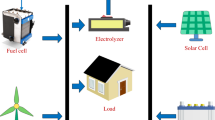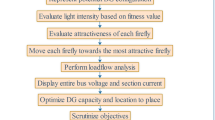Abstract
This paper proposes a modified bias (MB) and coefficient diagram method (CDM) based PID controller as a first attempt in controlling frequency of a self-reliant microgrid (MG) system under extreme unfavourable scenarios. Recently developed meta-heuristic algorithm, Grey Wolf Optimizer (GWO), is used for optimizing the parameters of the proposed controller GWO). Frequency deviation arises in the system due to active power mismatch between load power demand and actual power generation. In order to overcome this problem the CDM based gain values and frequency biased parameters of the MG system are used for determining the ranges of the control parameters for optimization with GWO which ensures that the search points generated by the search algorithm are stable ones. Simulation of the proposed GWO optimized MB-CDM controller-based MG system has been successfully implemented in real time simulation platform using digital simulator OPAL-RT. The performance of the system is obtained using proposed controller under different real-life scenarios and results are minutely analysed. The results are further compared with other relevant recent controllers including particle swarm optimization (PSO) MB-CDM controller to demonstrate that the proposed controller is superior to all other controllers. In addition, sensitivity analysis of the proposed controller for the MG system is studied under varying system parameters. The Simulink results illustrate that the proposed controller gives the best dynamic response amongst all other considered controllers in terms of peak transient deviation and settling time.












Similar content being viewed by others
References
Hassan B (2009) Robust power system frequency control, 2nd edn. Springer, Berlin
Shankar R, Chatterjee K, Chatterjee TK (2015) Coordination of economic load dispatch and load frequency control for interconnected power system. J Inst Eng India Ser B 96(1):47–54
Gemine Q, Ernst D, Cornelusse B (2017) Active network management for electrical distribution systems: problem formulation, benchmark, and approximate solution. Optim Eng 18(3):587–629
Balaguer IJ, Lei Q, Yang S, Supatti U, Peng FZ (2011) Control for grid-connected and intentional islanding operations of distributed power generation. IEEE Trans Ind Electron 58(1):147–157
Majumder R, Chaudhuri B, Ghosh A, Majumder R, Ledwich G, Zare F (2010) Improvement of stability and load sharing in an autonomous microgrid using supplementary droop control loop. IEEE Trans Power System 25(2):796–808
Al-Muhanna A, Al-Nujaimi A, Al-Baiyat S (2017) Robust H∞ and μ-Synthesis frequency control for two-bus islanded microgrid. Saudi Arabia Smart Grid SASG, Jeddah, pp 1–9
Bevrani H, Feizi MR, Ataee S (2016) Robust frequency control in an islanded microgrid: H∞ and µ-synthesis approaches. IEEE Trans Smart Grid 7(2):706–717
Shokoohi S, Golshannavaz S, Khezri R, Bevrani H (2018) Intelligent secondary control in smart microgrids: an on-line approach for islanded operations. Optim Eng 19(4):917–936
Pan I, Das S (2015) Kriging based surrogate modeling for fractional order control of microgrids. IEEE Trans Smart Grid 6(1):36–44
Sahoo BP, Panda S (2018) Improved grey wolf optimization technique for fuzzy aided PID controller design for power system frequency control. Sustain Energy Grids Netw 16:278–299
Padhan S, Sahu RK, Panda S (2014) Application of firefly algorithm for load frequency control of multi-area interconnected power system. Elect Power Compon System 42(13):1419–1430
Nguyen GN, Jaatheesan K, Ashour AS, Anand A, Dey N (2017) Ant colony optimization based load frequency control of multi-area interconnected thermal power system with governor dead-bans nonlinearity. Smart Trends Syst Secur Sustain 18:633–638
Sahu RK, Panda S, Rout UK, Sahoo DK (2016) Teaching learning-based optimization algorithm for automatic generation control of power system using 2-DOF PID controller. Int J Electr Power Energy Syst 77:287–301
Panda S, Yegireddy NK (2013) Automatic generation control of multi-area power system using multi-objective non-dominated sorting genetic algorithm-II. Int J Electr Power Energy Syst 53:54–63
Kennedy J, Eberhart R (1995) Particle swarm optimization. In: Proceedings of Int. Conf. on Neural Networks, Perth, WA, Australia, vol. 4, pp. 1942–1948
Storn R, Price K (1997) Differential evolution–a simple and efficient heuristic for global optimization over continuous spaces. J Global Optim 11(4):341–359
Rout UK, Sahu RK, Panda S (2013) Design and analysis of differential evolution algorithm based automatic generation control for interconnected power system. Ain Shams Eng J 4(3):409–421
Sahu RK, Panda S, Padhan S (2015) A hybrid firefly algorithm and pattern search technique for automatic generation control of multi area power systems. Int J Electr Power Energy Syst 64:9–23
Kassem AM, Abdelaziz AY (2015) BFA optimization for voltage and frequency control of a stand-alone wind generation. Electr Eng Unit 97(4):313–325
Sahu RK, Rout UK, Panda (2013) Sensitivity Analysis of Load-Frequency Control of Power System Using Gravitational Search Algorithm. In: Proceedings of Int. Conf. on Frontiers of Intelligent Computing: Theory and Applications, pp. 249–258
Barik AK, Das DC (2019) Coordinated regulation of voltage and load frequency in demand response supported bio-renewable cogeneration-based isolated hybrid microgrid with quasi-oppositional selfish herd optimisation. Int Trans Electr Energy Syst. https://doi.org/10.1002/2050-7038.12176
Bhuyan M, Barik AK, Das DC (2020) GOA optimised frequency control of solar-thermal/sea-wave/biodiesel generator based interconnected hybrid microgrids with DC link. Int J Sustain Energy. https://doi.org/10.1080/14786451.2020.1741589
Singh A, Suhag S (2019) Frequency regulation in an AC microgrid interconnected with thermal system employing multiverse optimized fractional order-PID controller. Int J Sustain Energy 39:1–13
Kumar B, Bhongade S (2016) Load disturbance rejection based PID controller for frequency regulation of a microgrid. In: Proceedings of Int. Conf. on Power and Energy Systems: Towards Sustainable Energy, Bangalore, pp 1–6
Mishra S, Mallesham G, Sekhar PC (2013) Biogeography based optimal state feedback controller for frequency regulation of a smart microgrid. IEEE Trans Smart Grid 4(1):628–637
Kumar B, Bhongade S (2017) Load disturbance rejection based PID controller for frequency regulation of a microgrid. Indones J Electr Eng Comput Sci 7(3):625–642
Mishra SS, Mishra SK, Swain SK (2017) Coefficient diagram method (CDM) based PID controller design for magnetic levitation system with time delay. In: Proceedings of IEEE Int. Conf. on Intelligent Techniques in Control, Optimization and Signal Processing, Srivilliputhur, pp 1–8
Mohamed TH, Shabib G, Ali H (2016) Distributed load frequency control in an interconnected power system using ecological technique and coefficient diagram method. Electr Power Energy Syst 82:496–507
Manabe S (1998) The coefficient diagram method. In: 14th IFAC symposium on Automatic control in aerospace, pp 24–28
Bhaba PK, Somasundaram S (2009) Real time implementation of a new CDM-PI control scheme in conical tank liquid maintaining system. CCSE Modern Appl Sci 3(5):38–45
Somasundaram S, Bhaba PK (2010) Control of bioreactor process using a new CDM-PID control strategy. J Eng Sci Technol 5(3):213–222
Thuengsripan S, Suksri T, Numsomran A, Kongratana V, Roengruen P (2007) Smith predictor design by CDM for temperature control system. In: Proceedings of Int. Conf. on Control, Automation and Systems, Seoul
Kalpana K, Meenaakshipriya B (2014) Design of coefficient diagram method (CDM) based PID controller for double integrating unstable system. In: Proceedings of IEEE Int. Conf. on Electrical Engineering Systems, Chennai, India
Imal E (2009) CDM based controller design for nonlinear heat exchanger process. Turk J Electr Eng Comput Sci 17(2):143–161
Somasundaram S, Bhaba PK (2009) A new CDM PIPD control strategy for unstable process. Int J Eng Simul 10(1):19–24
Manabe S (2003) Importance of coefficient diagram in polynomial method. In: Proceedings of IEEE Int. conf. on decision and control, Maui, HI, USA, December 2003
Raj R, Anand LDV (2013) Design and implementation of a CDM-PI controller for a spherical tank level system. Int J Theor Appl Res Mech Eng 2(1):49–52
Mirjalili S, Mirjalili SM, Lewis A (2014) Grey wolf optimizer. Adv Eng Softw 69:46–61
Padhy S, Panda S, Mahapatra S (2017) A modified GWO technique-based cascade PI-PD controller for AGC of power systems in presence of plug in electric vehicles. Eng Sci Technol 20(2):427–442
Kumar B, Adhikari S, Datta S, Sinha N (2019) Real time simulation of modified bias based load disturbance rejection controller for frequency regulation of islanded micro-grid. Int J Emerg Electr Power Syst 20(5):1–13
Guha D, Roy PK, Banerjee S (2016) Load frequency control of interconnected power system using grey wolf optimization. Swarm Evol Comput 27:97–115
Kundur P (2009) Power system stability and control. Tata McGraw-Hill, New Delhi
Elgerd OI (2007) Chapter 6. In: Electric energy systems theory: an introduction. Tata McGraw-Hill Publishing Company Ltd, New Delhi
Acknowledgements
We take this opportunity to offer our wholehearted gratitude to TEQIP-III project for making available OPAL-RT Loop Simulator at NIT Manipur which assisted us to validate all responses of the proposed controller based MG system in real time environment.
Author information
Authors and Affiliations
Corresponding author
Additional information
Publisher's Note
Springer Nature remains neutral with regard to jurisdictional claims in published maps and institutional affiliations.
Appendix
Appendix
Nominal parameters of the MG:
fsys = 50 Hz, Pbase = 1MVA, D = 0.012 MW/Hz, M = 0.2 s, Tdegg = 2 s, Tdegt=20 s, Tfc = 4 s, Tae = 0.2 s, \(T_{bess}\) = 0.1 s, Tfess = 0.1, Kdegg = Kdegt = Kae = Kbess = Kfess = 1, TWT = 1.5 s, TPV = 1.8 s, KWT = KPV = 1.
Rights and permissions
About this article
Cite this article
Kumar, B., Adhikari, S., Datta, S. et al. Real Time Simulation for Load Frequency Control of Multisource Microgrid System Using Grey Wolf Optimization Based Modified Bias Coefficient Diagram Method (GWO-MBCDM) Controller. J. Electr. Eng. Technol. 16, 205–221 (2021). https://doi.org/10.1007/s42835-020-00596-2
Received:
Revised:
Accepted:
Published:
Issue Date:
DOI: https://doi.org/10.1007/s42835-020-00596-2




